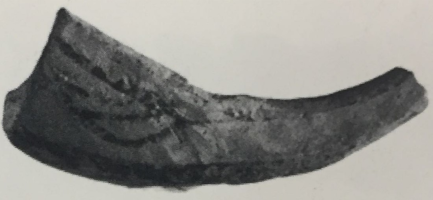Hull fragment with both extremities lost. The interior has a keel line and four ribs painted. The interior has small dashes of paint.
Fragmentary ship model
A12
LH IIIA:2-B (?) (1390/70-1200/1190)
Sanctuary of Aphaia, Aigina. MT 475
L: 6.7 cm; W: 4.5 cm
Terracotta model fragment, pale yellow clay, thin creamy slip, dark brown paint
Aigina Archaeological Museum 54
Davaras 1984: 63, no. 41; French 1971: 173-174; Pilafidis Williams 1998: 77, nos. 534-535, pls. 56.534, 56.535; Wedde 2000: 311-312, nos. 321, 335
The LBA occupation is characterized as an open-air hill sanctuary dedicated to a female deity, probably connected to children and fertility (Pilafidis Williams 1998: 149). The LBA objects were found either on or close around the highest outcrop of rock on the hill, a position which provides a view of the entire island as well as the highest mountain of Aigina (mount Oros) and the surrounding valleys. On a clear day, it is possible to see from Corinth to Athens in one direction and as far as Melos in the other. There are no architectural structures relating to the period or even an altar, but it is quite likely that the latter was obliterated by later activity. There was also no settlement in the vicinity. This period of use is defined by the unusually large quantity of terracotta figurines (698), which are more plentiful than the pottery (408). These offer a large variety of female, animal and group subjects. Amongst the figurines, the main peculiarity is the high number of kourotrophoi, followed by hedgehog vessels. The former were probably introduced from the Argolid, where they occur in larger quantities and begin earlier, whereas they only appear on Aigina in LH IIIA:2 and increase in LH IIIB.
The special role of the site is inferred by the presence of a large number of unusual terracotta types such as Hollow Psis, Kourotrophoi, chariots, ridden oxen, boats and thrones. In addition to terracotta, the site provides an unusually high number of seals (33), as well as some beads, pendants and a few metal objects but no gold or ivory. The large amounts of fine ware pottery and seals suggest some degree of wealth and organisation of the sanctuary. The number of figurines nonetheless point to a popular communal cult where many people were involved, including some richer dedicators.
Pilafidis Williams has argued that the cult had some association with the sea, drawing a possible connection between the boat models and the later known legends about the goddess Aphaia, which was said to have come from abroad, possibly Crete (Ibid: 145). This connection, while attractive, is very speculative considering how late in date the legends are. It should also be stressed that the boat models represent a tiny fraction of the terracotta assemblage (0.003%) and therefore appear to be a highly unusual type at the site. The sanctuary did receive some imported figurines and vessels from the Argolid,(Ibid: Appendix II) and it is very likely that Aigina was a stopping point for ship coming from the Peloponnese on their way to the eastern Mediterranean. Its position on the eastward trade route is supported by the presence of high quality pieces such as the vertical globular flask and the hedgehog shaped rhyta which were particularly valued in the east. Most shapes found at Aphaia and at Aigina Town are in fact attested from Cyprus and the Levant, while Aigina Town has provided fragments of Cypriot pottery as well as a tripod stone mortar.
Davaras, C. 1984. “Μινωϊκò κηριοφόρο πλοιάριο τῆς Συλλογῆς Μητσοτάκη,” AE: 55-95.
French, E. 1971. “The Development of Mycenaean Terracotta Figurines,” BSA 66: 101-187.
Pilafidis Williams, K. 1998. The Sanctuary of Aphaia on Aigina in the Bronze Age. München: Deutsches Archäologisches Institut.
Wedde, M. 2000. Towards a Hermeneutics of Aegean Bronze Age Ship Imagery. Peleus Studien zur Archäologie und Geschichte Griechenlands und Zyperns, vol. 6. Bibliopolis: Mannheim and Möhnsee.




